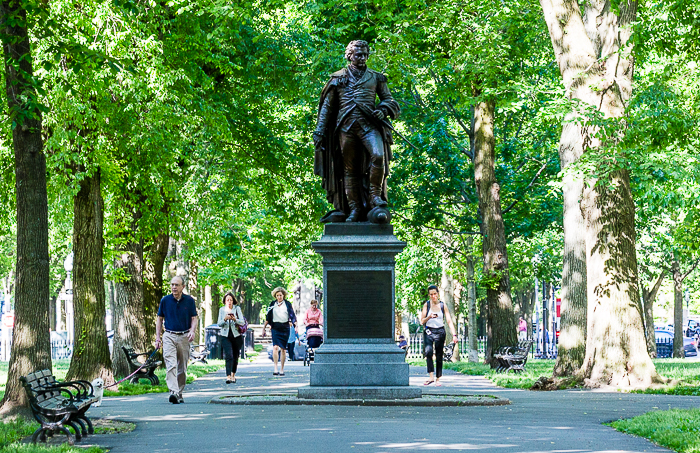
John Glover statue on Commonwealth Avenue Mall
Created by renowned sculptor Martin Milmore, a bronze statue of Colonel John Glover stands in the Berkeley-Clarendon block of Commonwealth Avenue Mall. He has one foot on the barrel of a cannon, holds a sword sheath in his left hand and the sword in his right. But who is this hero? He was a three-time savior of American independence!
John Glover was a self-made man who built a fleet of fishing schooners in Marblehead and traded with Spain and Portugal as part of the fishing industry, becoming a well-respected member of the “codfish aristocracy” on the North Shore. As the war for independence grew imminent, Glover raised ten companies of about 500 fisherman and sailors some of whom were Spanish, Native American, Jewish and African-American who would become the 14th Continental Regiment known as the “Marblehead Mariners”.
1776 was a difficult year for the fledgling Patriot army during the Revolutionary War. During the New York-New Jersey campaign from August through December, the British came close to destroying George Washington’s forces. Three times, Colonel John Glover — with his expert seamanship, military leadership and just plain grit — saved the American Independence movement in the early dark days when it appeared the Revolution had been crushed.
- The Patriot army suffered a crushing defeat at the Battle of Brooklyn in August 27, 1776. Glover’s first save of the American Army occurred when early on the 28th, he led his regiment across to Brooklyn from Manhattan and evacuated Washington’s 9,000 men, field pieces, heavy ordinance and all ammunition, as well as horses, cattle and provisions across the East River in nine hours!
- In October of the same year, Glover was in temporary command of four Massachusetts Continental regiments. He was ordered to disrupt 4,000 British and Hessian troops landing on shore to trap the main body of American troops in northern Manhattan. Outnumbered and commanding troops on land, he successfully delayed the British advance at the Battle of Pell’s Point so that Washington’s troops could reach White Plains. The armies fought at White Plains, with another British victory but with the delay allowing Washington to retreat across New Jersey to Philadelphia.
- Glover rejoined Washington’s forces in early December in Philadelphia. The Continental Army was completely exhausted and demoralized, and most of the men’s enlistments expired on December 31. Washington, with legendary leadership, convinced enough of his army to delay leaving, and planned an attack on the most vulnerable town across the Delaware River. On the night of December 25th, below Trenton, Glover and his “Marbleheaders” ferried 2,400 troops – with horses, artillery and wagons – across the icy Delaware River in the snow. After marching several miles, the tough New Englanders fought in the Battle of Trenton, and then transported the army and about 1,000 Hessian prisoners back across the Delaware, all on the same day!
While not a strategic victory, news of the success at Trenton raised the spirits of the American colonists, who previously feared that the Continental Army was incapable of victory.

